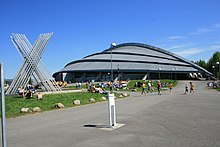
Back ملعب متعدد الأغراض Arabic বহুমুখী স্টেডিয়াম Bengali/Bangla Pavelló esportiu Catalan Estadio multiusos Spanish Kiroldegi Basque ورزشگاه چندمنظوره Persian Stade multifonction French Impianto sportivo polivalente Italian 다목적 경기장 Korean สนามกีฬาอเนกประสงค์ Thai
This article needs additional citations for verification. (July 2007) |



A multi-purpose stadium is a type of stadium designed to be easily used for multiple types of events. While any stadium could potentially host more than one type of sport or event, this concept usually refers to a design philosophy that stresses multifunctionality over speciality. It is used most commonly in Canada and the United States, where the two most popular outdoor team sports—Canadian football or American football and baseball—require radically different facilities. Football uses a rectangular field, while baseball is played on a diamond with a large outfield. Since Canadian football fields are larger than American ones, the design specifications for Canadian facilities are somewhat less demanding. The particular design to accommodate both is usually an oval, although some later designs use an octorad. While building stadiums in this way means that sports teams and governments can share costs, it also presents some challenges.
In North America, multipurpose stadiums were primarily built during the 1960s and 1970s as shared home stadiums for Major League Baseball and National Football League or Canadian Football League teams. Some stadiums were renovated to allow multipurpose configurations during the 1980s. This type of stadium is associated with an era of suburbanization, in which many sports teams followed their fans out of large cities into areas with cheaper, more plentiful land. They were usually built near highways and had large parking lots, but were rarely connected to public transit. As multipurpose stadiums were rarely ideal for both sports usually housed in them, they had fallen out of favor by the 1990s, with the SkyDome (in Canada) that opened in 1989 being the last such stadium completed to accommodate baseball and football. With the completion of the Truman Sports Complex in Kansas City in 1973, a model for purpose-built stadiums was laid down. Since the Baltimore Orioles left the multi-purpose Memorial Stadium for the baseball-only Oriole Park at Camden Yards in 1992, most major league sports stadiums have been built specifically for one sport. However, some newer NFL stadiums (e.g. Seattle, Atlanta, Charlotte) have been built with consideration for the possible use of the stadium for Major League Soccer or international soccer, which has similar field dimensions to American football. Fields that are suitable for soccer are almost always equally suitable for either rugby code (rugby union or rugby league), and the 2031 Rugby World Cup is expected to employ the same stadiums as the NFL and MLS.
Outside North America, the term is rarely used, since association football (i.e., soccer) is the only major outdoor team sport in many countries; in many other countries, association football and rugby can easily coexist with limited venue conversion required beyond goalpost changes and line markings. In Australia, many sports grounds are suited to both Australian rules football and cricket, as Australian Rules fields and laws are laid out on cricket ovals. In some cases, such as at Stadium Australia in Sydney, Docklands Stadium in Melbourne, and National Stadium, in Singapore, stadiums are designed to be converted between the oval configuration for cricket and Australian rules football and a rectangular configuration for rugby and association football, and in the case of Singapore's National Stadium, an athletics configuration as well. Association football stadiums have historically served as track and field arenas, too, and some (like the Olympiastadion in Berlin) still do, whereas a newer generation frequently has no running track, in order to allow the fans closer to the field. This has created some difficulties with creating large athletics venues for major championships, as fans are less willing to accept the compromises required in the design of such stadiums, an issue that has bedevilled, e.g. the London Stadium since the 2012 Summer Olympics and was avoided in the commonwealth Games stadiums of 2000 and 2014 by returning the stadiums to football-only use, and in 2022 by having the national athletics body as the sole primary tenant of a renovated stadium.
Winter sports facilities, especially speed skating rinks, can be multi-purpose stadiums. Very often, a rink or two of approximately 61 by 30 meters—the regulation size of an IIHF ice hockey rink—are placed inside the oval. Sometimes the ice surface is even larger, allowing for both bandy and curling.
In Ireland, the first of two national stadiums, Aviva Stadium, is shared by football and rugby union, although only rugby union has a club team, Leinster Rugby, that regularly uses the facility. The other larger national stadium, Croke Park, hosts three different sports regularly: gaelic football, hurling, and its women's equivalent, camogie. All three are gaelic games run by the same organisation, the Gaelic Athletic Association (GAA), and the rules of each game are mapped onto the same dimensions—although some pitches in areas where hurling is the dominant code have longer pitches slightly more suited to faster, longer passes in the hurling game. When the Aviva was being rebuilt, Croke Park stepped in as home for the national teams in both soccer and rugby union, a decision of significant political weight in the nation's history. Gaelic grounds can easily accommodate both as the typical Gaelic pitch, while similarly rectangular, is significantly longer and wider than the fields used for soccer and rugby union, which are almost identical in dimensions. Historically, however, the GAA has been reluctant to allow 'foreign' sports to use its facilities, although these objections were set aside both for the rebuild of the Aviva and for the ultimately unsuccessful 2023 Rugby World Cup bid. Croke Park and Aviva have both occasionally hosted visiting American football college matches, especially those featuring the Army and Navy, or Notre Dame, with which Ireland has a long-standing connection.